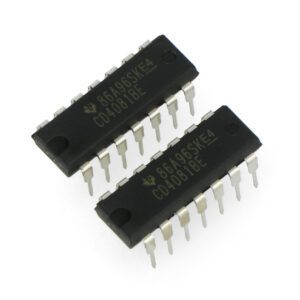Table of Contents:
Logic circuits are the foundation of modern electronics, underpinning the operation of many digital computing systems.
These small components convert simple signals into complex operations that drive a range of devices – from simple clocks to issue computers to sophisticated control systems.
What specifically are they?
Where are they most often used?
What should every electronics or programming enthusiast know about them?
Check out the article, in which we provide answers to the most important questions about logic circuits.
Where did logic circuits come from?
Origins of logic circuits date back to the 19th century, when English mathematician George Boole developed algebraic assumptions that provided the theoretical basis for binary logic and operations on binary variables. Boole’s algebra became the foundation on which later theories and technologies were built.
The breakthrough came in the first half of the 20th century, when designs such as mechanical and electromechanical relays, and later vacuum tubes, began to be used to create simple logic circuits.
A key moment in history, however, was the invention of the transistor in 1947 by Bardeen, Brattain and Shockley, which revolutionized electronics, enabling miniaturization and significantly increasing the performance of logic circuits.
Since then, these circuits have become the foundation of rapidly developing digital electronics, paving the way for the era of computers, smartphones and the myriad digital devices that today are an integral part of our daily lives.
What are logic circuits?
Logic circuits, which are basic components of digital electronics, play a key role in processing and manipulating binary data.
They operate on a simple premise where input signals, represented by high (1) or low (0) states, are processed according to the rules of logic operations to produce a specific output signal.
This binary nature makes them extremely effective in digital environments where all information is represented by two states.
Basic logic circuits, also known as logic gates, are:
- AND – produces a high signal at the output (1) only if all its inputs are high.
If any input is low (0), the output will also be low. - OR – an OR logic circuit gives a high signal at the output when at least one of its inputs is high.
The output is low only when all inputs are low. - NOT – A NOT gate, also known as an inverter, has only one input.
It inverts the input state: if the input is high, the output will be low, and vice versa. - NAND – the NAND circuit is the negation of AND.
It gives a low signal at the output only when all its inputs are high.
In any other case, the output is high. - NOR – is the negation of the OR gate.
It gives a high signal at the output only if all its inputs are low.
Otherwise, the output is low. - XOR – XOR gate produces a high signal at the output only when the number of high input signals is odd.
In particular, for two inputs, the output is high when the inputs are different. - XNOR – is the negation of the XOR gate.
It gives a high signal at the output when the inputs are the same.
For two inputs, the output is high when both inputs are low or both inputs are high.
The design of logic circuits begins with defining the desired function that the circuit is to perform.
Then, using truth tables, one determines how the circuit should respond to various combinations of input signals.
A truth table is nothing more than a logic matrix that records all possible input combinations and their corresponding output results for a given circuit.
This tool is the foundation of design, allowing precise planning of the circuit’s operation even before its physical execution.
Where are logic circuits used?
Logic circuits are used in almost every aspect of modern electronics.
Here are some of their key applications:
1. microprocessors and microcontrollers
At the heart of most modern electronic devices are microprocessors and microcontrollers, which consist of millions of small logic circuits.
They are responsible for processing data, executing program code and controlling other system components.
2. consumer electronics
In televisions, game consoles and many other electronic devices, logic circuits are used to process signals, operate user interfaces and manage device functions.
3. communication
In communication systems such as Wi-Fi, Bluetooth and Ethernet, logic circuits are used to encode, decode, transmit and receive data.
4. industrial automation and control
In industry, logic circuits are the backbone of machine and process control systems, enabling automation and production monitoring.
5. electronic projects
Logic circuits are extremely popular among DIY electronics enthusiasts and hobbyists who create their own devices.
They are useful when constructing a wide range of devices, from simple educational toys to more complex systems such as home automation.
What else is worth knowing about logic circuits?
Logic circuits are the backbone of digital electronics operation, enabling the processing of binary information in a wide range of devices, from simple gadgets to sophisticated computer systems.
Their versatility and ability to perform complex operations by combining simple logic functions make them indispensable in today’s technological landscape.
Understanding how logic circuits work opens the door to a deeper understanding of electronics, computer science and the development of new technologies.
In addition, their availability and relatively low price make them attractive to hobbyists and DIY enthusiasts who can experiment by creating their own electronic projects.
How useful was this post?
Click on a star to rate it!
Average rating 3 / 5. Vote count: 1
No votes so far! Be the first to rate this post.




















